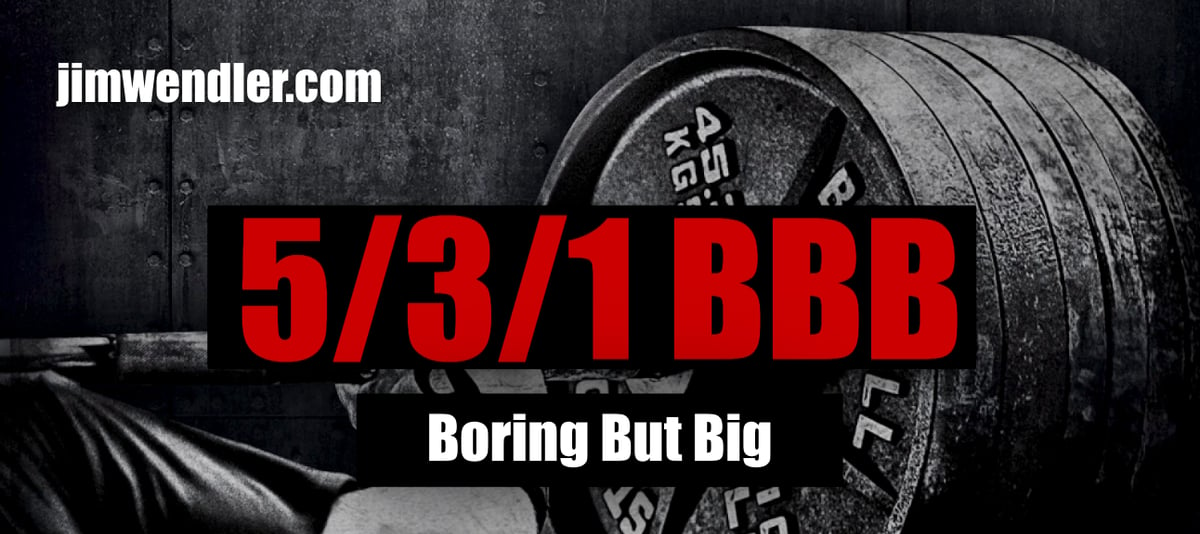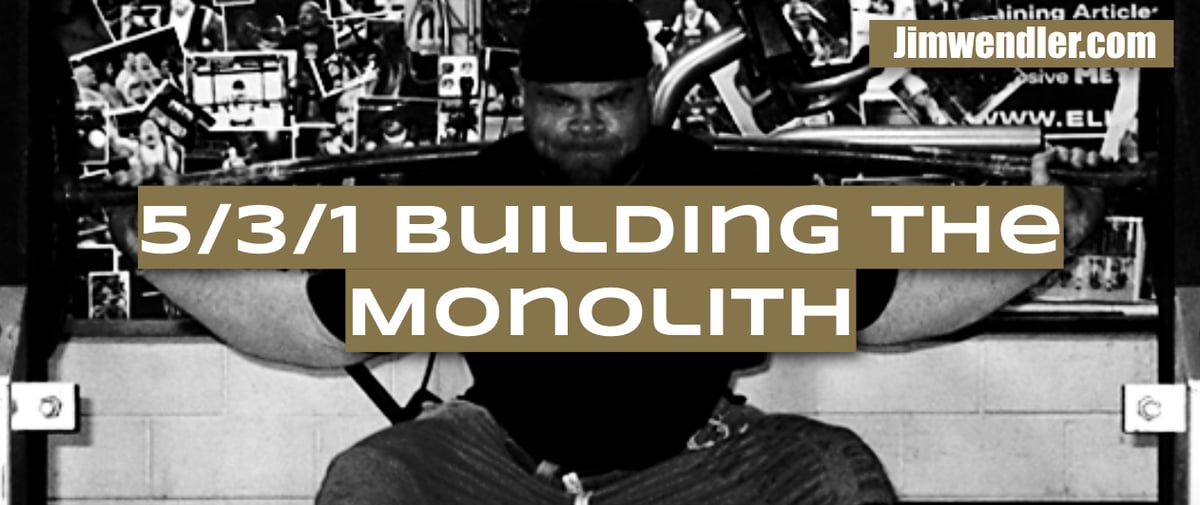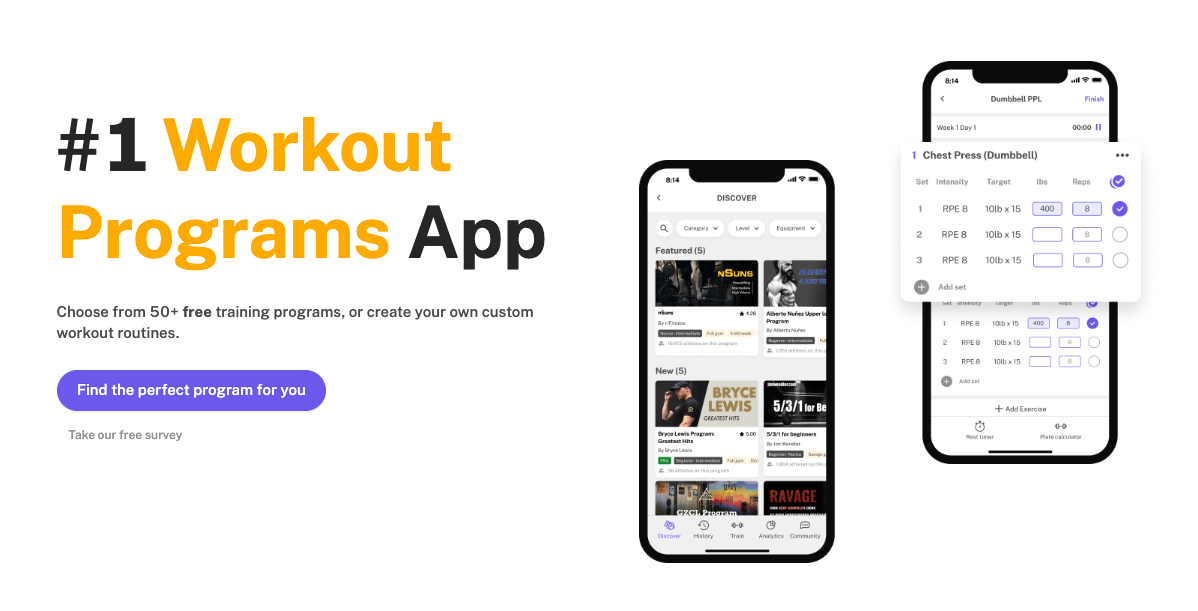5/3/1 Program | Best Guide + Free App
Written by The Boostcamp Editors
Is 5/3/1 the best powerlifting program?
If you've dabbled in strength training, whether that by something such as Olympic Weightlifting or powerlifting, then you've probably heard of 5/3/1 by Jim Wendler. The 5/3/1 philosophy is one of the most famous powerlifting training programs for building strength. The 5/3/1 program has been tried and tested by thousands of strength athletes, from beginner gym goers who just want to get stronger, to elite level powerlifters trying to win gold in their competitions.
The 5/3/1 Workout Program Overview
You may be wondering, what exactly the 5/3/1 program is, and to be fair, it can be quite confusing. Is it for muscle mass, is it for strength, or is it for both? In this comprehensive 5/3/1 workout program guide, we'll not only thoroughly explain 5/3/1 philosophy and all the 5/3/1 program templates, but also show you how to get started right away.
First, if you want to take an in depth dive into 5/3/1 philosophy, there is no better resource than Jim Wendler himself, the man who wrote the program. We highly recommend Jim Wendler's books, 5/3/1 (2nd Edition) and 5/3/1 Forever, where he explains the protocol in detail and share 50+ 5/3/1 program templates for your specific training level and goals.
Best 5/3/1 Workout Program Variations (Free)
If you already know you want to try the 5/3/1 program, then check out the Boostcamp App. Boostcamp has included three of the most popular 5/3/1 programs into a free workout app, so you can try them out without having to pay anything. Boostcamp turns popular spreadsheet programs into our simple-to-use app format, with 1RM onboarding, auto weight progressions, and exercise guidance videos. Let's check out each of the 5/3/1 workout programs that Boostcamp has to offer.
5/3/1 for Beginners

5/3/1 for Beginners: If you're relatively new to barbell strength training (meaning you have less than 1 year of consistent training under your belt), then the 5/3/1 for Beginners program is right for you. It primarily focuses on building proficiency in the big 4 compound lifts: squat, bench, deadlift, overhead press. The 5/3/1 for Beginners program has some of the fastest weight progressions because people who are newer to the gym tend to make those newbie gains.
5/3/1 Boring But Big

5/3/1 Boring But Big: The 5/3/1 Boring But Big, or BBB, program is for those who are more so intermediate lifters, meaning that they have about 1-2 years of consistent training, who want to increase strength in the big 4 compound lifts, but also want to build some solid muscle by doing a decent amount of volume on the compounds. 531 BBB progresses weights at a slower speed than 5/3/1 for Beginners.
5/3/1 Building the Monolith

5/3/1 Building the Monolith: The 5/3/1 Building the Monolith, or BtM, template is for those who are intermediate-advanced lifters, meaning that they have 2+ years of consistent training, who want to increase strength, but also build serious muscle by doing a ton of volume on accessory movements such as pull-ups, dips, facepulls, etc. This program is perfect for those who've finished a few cycles of the 5/3/1 BBB program.
Best 5/3/1 Program Guide
What is the 5/3/1 program? What does 531 mean?
First, 5/3/1 program is not one specific program, but instead it is actually a training system with many different programs for athletes of different levels (beginners, intermediates, advanced) and goals (strength, muscle, athletics). At a high level, 5/3/1 describes a rep scheme: 5 reps, 3 reps, and 1 rep. The lower the reps, the heavier the weights used.
The rep scheme of the 5/3/1 program can be illustrated by the example below:
The 5/3/1 progression format is used for compound lifts: squat, bench, deadlift, and overhead press. Accessory exercises for hypertrophy and fixing strength weaknesses are done at higher rep ranges without fixed 5/3/1 progression.
The actual % of 1RM, sets and reps schemes are dependent on the different variations of 5/3/1 templates. For example, 5/3/1 for Beginners will progress the compound lifts at a faster rate than 5/3/1 Boring But Big, because beginners should technically be able to gain strength weekly, while intermediates can only gain strength monthly.
What are 5/3/1 percentages?
The 5/3/1 percentages are the percentage of your one rep max (1RM) that you will be using for the 5/3/1 sets and reps. For example, if your 1 rep max is 200lbs, and you're doing 5/3/1 for Beginners, your 5/3/1 percentages will be:
Set 1: 65% of 200lbs (130lbs) for 5 reps
Set 2: 75% of 200lbs (150lbs) for 5 reps
Set 3: 85% of 200lbs (170lbs) for 5 or more reps (5+)
Set 4-8: 65% of 200lbs (130lbs) for 5 reps per set
So how this works is that you gradually increase weight to a top set at 85%, which you do for an AMRAP (as many reps as possible) for 5 or more reps. This is to help you test the boundaries and train closer to failure. Then you would back down the percentage intensity to 65% for 5 sets to build volume, which will help you build muscle.
Why should I do the 5/3/1 strength program?
5/3/1 is a training system with many different programs, but primary used by powerlifters to build strength. Why should you follow 5/3/1? Well, it is one of the most famous programs on the internet for a reason, it works. Thousands of athletes have followed 5/3/1 program templates to build muscle and mass. It is brutally simple and effective, taking the guesswork and fluff out of all the fluffy workouts out there.
Will the 5/3/1 program build muscle?
The 5/3/1 system was designed to build strength, meaning that it may not be the best bodybuilding workout program, but many athletes have used different 5/3/1 templates to build muscle. 5/3/1 Boring But Big is a popular 531 program for building muscle. 531 Building the Monolith is another excellent 5/3/1 variation for packing on size.
Can I do 5/3/1 workout at home?
Yes and no. 5/3/1 workouts can be done at home with a few pieces of equipment: a barbell, weight plates, and a squat rack. If you don't have access to a squat rack, you can start doing 5/3/1 with dumbbells. However, unless your dumbbells are easily adjustable for different weights, and go up to a high weight, you're going to have trouble progressing using the 5/3/1 format. If you're looking for a free dumbbell program to build muscle and strength, we highly recommend the free Dumbbell PPL on Boostcamp App, which is a dumbbell-focused program.
How long should I follow 5/3/1 workout program?
The 5/3/1 system is designed to be run in 4-week cycles. After 4 weeks, you deload (take a week easy) and then start the cycle again. The 5/3/1 training system can be run indefinitely. As your strength and size increases, you will need to adjust the 5/3/1 percentages upwards.
That said, there are many 5/3/1 templates for you to do, depending on your level and goals. If you're a beginner, which means you have less than 1 year of consistent training experience, you should follow 5/3/1 for Beginners. This program progresses in weight faster than intermediate programs. Assuming you're eating and recovering, you should be able to make progress on this program for 6-12 months.
Past the beginner stage, you become an intermediate, and you should follow 5/3/1 Boring But Big (531 BBB). This program progresses in weights a little slower than 5/3/1 for Beginners to better suit intermediates, and also has more accessory volume to help you build strength and muscle. If you are eating and recovering correctly, you should also be able to run this program for 6-12 months.
After 5/3/1 BBB, you can try 5/3/1 Building the Monolith (531 BtM), which is a more advanced, highly demanding program with a ton of accessory volume. You can run this program for as long as it is effective.
What if I stall on 5/3/1? What if I fail on 5/3/1?
If you failed lifts for a single session, it could be due to a lot of external short-term variables, like you had poor sleep, poor diet, you drank 2 nights ago, you had a bad day at work, you didn't stretch, etc etc. This is TOTALLY normal and might even happen for a few consecutive sessions. Come back next workout and continue.
If you failed 5/3/1 lifts for multiple consecutive sessions, now it is time to re-evaluate. Ask yourself the following questions:
Do you need a deload? If you've been skipping deloads, or you didn't properly decrease volume and intensity during a deload, it might be time. Decrease weights and reps by 50% for a week, then come back and see if you're recovered and ready to go.
Are you properly recovering? Are you getting adequate sleep and calorie surplus? If not, you need tune those in order. If you are cutting, you're going to likely lose some muscle and strength. If you're bulking, are you eating sufficient protein? A solid amount of carbs to fuel your training?
Did you f*** with the program? Did you add a bunch of accessories yourself because you felt like the program was too easy? Did you increase weight way faster than what 5/3/1 spit out? Well, don't do that.
Did you enter your 1RM too high? Instead of entering conservative training maxes that you can currently do, did you enter your all time 1 rep maxes? Progress in weights doesn't have to be at maximal levels. If you're overestimating, you're likely shooting yourself in the foot.
What are 5/3/1 accessory exercises?
Accessory exercises are additional lifts that are done to supplement the 5 main 5/3/1 compound lifts. These accessory 531 lifts can be used to correct strength imbalances, build muscle, or improve athleticism.
What are 5/3/1 sets and reps?
The 5/3/1 rep scheme is 5 reps, 3 reps, and 1 rep. The 5/3/1 sets and reps depend on the variation of 531 template that you're following. For example, 5/3/1 for Beginners has you do 5 sets of 5 reps, 5 sets of 3 reps, and 5 sets of 1 rep. 5/3/1 Boring But Big has you do 5 sets of 10 reps on the 531 accessory lifts.
5/3/1 Calculator
One of the most important aspects of 5/3/1 is calculating your 5/3/1 percentages. There are many 5/3/1 calculators out there, but we recommend using the Boostcamp App, which has 3 of the most popular 531 templates and it is completely free to use.
5/3/1 Workout Sheets
Another important aspect of 5/3/1 is having 5/3/1 workout sheets to track your progress, which is crucial to make sure you are on the right track. There are many different 5/3/1 workout sheets available online, but we recommend using the Boostcamp App, which has 3 of the most popular 5/3/1 templates for free.
5/3/1 Program Reviews
If you are looking for more information on the 5/3/1 programs, check out some program reviews for each one. These will help to provide good insight for you to choose a program and make some gains.
5/3/1 Boring But Big reviews Boostcamp
5/3/1 Building the Monolith reviews
5/3/1 for Beginners reviews Reddit
5/3/1 Boring But Big reviews Reddit
5/3/1 Building the Monolith reviews Reddit
If you're thinking about starting 5/3/1, we recommend reading some of these 5/3/1 reviews to get an idea of what other lifters think about the program.
5/3/1 vs Sheiko
5/3/1 and Sheiko are two of the most popular strength training programs out there. 5/3/1 is a linear progression program that has you increasing the 5/3/1 percentages each week. Sheiko is a block periodization program that has you cycling through different intensity levels every 4 weeks.
5/3/1 vs Madcow
5/3/1 and Madcow are two of the most popular strength training programs out there. 5/3/1 is a linear progression program that has you increasing the 5/3/1 percentages each week. Madcow is a linear progression program that has you increasing the weight on the bar every week.
5/3/1 vs Stronglifts 5x5
5/3/1 and Stronglifts 5x5 workout programs are two of the most popular strength training programs out there. 5/3/1 is a linear progression program that has you increasing the 5/3/1 percentages each week. Stronglifts 5x5 is a linear progression program that has you increasing the weight on the bar every week.
5/3/1 vs Starting Strength
5/3/1 and Starting Strength are two of the most popular strength training programs out there. 5/3/1 is a linear progression program that has you increasing the 5/3/1 percentages each week. Starting Strength is a linear progression program that has you increasing the weight on the bar every week.
Finding More Workout Programs
If the 5/3/1 workout program does not interest you, keep in mind that there are plenty of good programs available on Boostcamp. A good program will keep you on track, making sure that you are making the most gains. If you are looking to stay on track and continue with linear progression, then finding a good workout program is the key. Where do you look for a good workout program? Check out the Boostcamp App for some great programs.
Boostcamp is home to over 50 FREE workout programs that consist of strength, hypertrophy, or functional fitness, or both, from the push pull legs program all the way to upper lower, there are so many programs to choose from that can help fit your needs. However, with Boostcamp, you don’t have to just follow a pre-written program (although each program is written by a professional), you also can create your own program as well, and track your progress to make sure you are on the right track. That being said, when you are looking to incorporate some serious training to further your progress in your fitness journey, then check out Boostcamp.
Wrap Up
Overall, the 5/3/1 program is a great powerlifting program written by Jim Wendler that can help you make some serious progress. There are many 5/3/1 apps out there, but in our opinion, the best 5/3/1 app is Boostcamp. Boostcamp has 3 of the most popular 531 templates (5/3/1 for Beginners, 5/3/1 Boring But Big, 5/3/1 Building the Monolith) and it is completely free to use, and you can choose from plenty of other programs or even make your own.
Will you be giving it a try?
Be sure to follow Boostcamp on Instagram and subscribe on YouTube!


